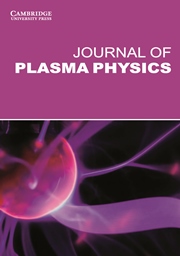Article contents
Plasma-driven Z-pinch X-ray loading and momentum coupling in meteorite and planetary materials
Published online by Cambridge University Press: 29 August 2012
Abstract
X-ray momentum coupling coefficients, CM, were determined by measuring stress waveforms in planetary materials subjected to impulsive radiation loading from the Sandia National Laboratories Z-machine. Velocity interferometry (VISAR) diagnostics provided equation-of-state data. Targets were iron and stone meteorites, magnesium-rich olivine (dunite) solid and powder (~5–300 μm), and Si, Al, and Fe calibration targets. Samples were ~1-mm thick and, except for Si, backed by LiF single-crystal windows. X-ray spectra combined thermal radiation (blackbody 170–237 eV) and line emissions from pinch materials (Cu, Ni, Al, or stainless steel). Target fluences of 0.4–1.7 kJ/cm2 at intensities of 43–260GW/cm2 produced plasma pressures of 2.6–12.4 GPa. The short (~5 ns) drive pulses gave rise to attenuating stress waves in the samples. The attenuating wave impulse is constant, allowing accurate CM measurements from rear-surface motion. CM was 1.9 − 3.1 × 10−5 s/m for stony meteorites, 2.7 and 0.5 × 10−5 s/m for solid and powdered dunite, 0.8 − 1.4 × 10−5 s/m for iron meteorites, and 0.3, 1.8, and 2.7 × 10−5 s/m respectively for Si, Fe, and Al calibration targets. Results are consistent with geometric scaling from recent laser hohlraum measurements. CTH hydrocode modeling of X-ray coupling to porous silica corroborated experimental measurements and supported extrapolations to other materials. CTH-modeled CM for porous materials was low and consistent with experimental results. Analytic modeling (BBAY) of X-ray radiation-induced momentum coupling to selected materials was also performed, often producing higher CM values than experimental results. Reasons for the higher values include neglect of solid ejecta mechanisms, turbulent mixing of heterogeneous phases, variances in heats of melt/vaporization, sample inhomogeneities, wave interactions at the sample/window boundary, and finite sample/window sizes. The measurements validate application of CM to (inhomogeneous) planetary materials from high-intensity soft X-ray radiation.
Information
- Type
- Papers
- Information
- Copyright
- Copyright © Cambridge University Press 2012
References
- 8
- Cited by

